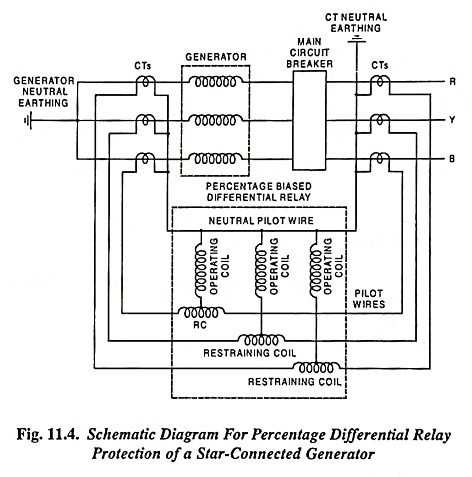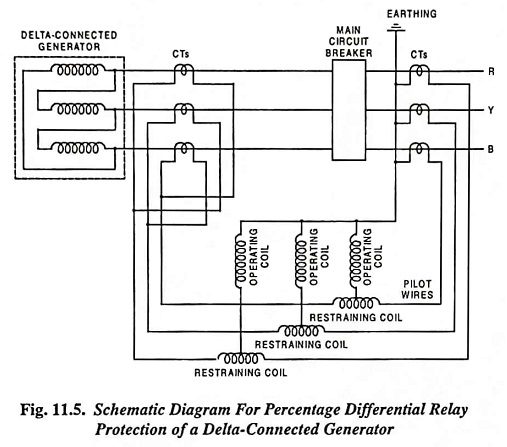Percentage Differential Relay Protection of Generator:
This system, also called the Merz-Price protection system, is the most common type of protection used for stator windings against phase-to-phase or phase-to-ground faults. It is the standard practice of manufacturers to recommend differential protection for generators rated 1 MVA or higher, and most of such generators are protected by differential relays. Above 10 MVA, it is almost universally the practice to use differential relays. Generally, Percentage Differential Relay Protection of Generator is used, protecting about 80% of the stator winding.
When differential relaying is used for protection, the CTs at both ends of a generator winding must be of equal accuracy; otherwise if the error is excessive it will cause a maloperation of the relay. To safeguard against such an operation, biased circulating current protection is used. Such a protection provides a biasing feature which automatically increases the relay setting in proportion to the load or through fault current, i.e., the relay is set to operate not at a definite current, but at certain percentage of the through current.
By suitably proportioning the ratio of the restraining coil turns to the operating coil turns, any amount of biasing can be achieved and compensation for unwanted operations due to spurious spill currents can be provided.
Advantages of Percentage Differential Relay Protection of Generator:
- It does not require CTs with air gaps or special balancing features.
- It permits a low fault setting to be used and this ensures maximum protection of the windings.
- It ensures complete stability under the most severe through fault conditions.
The protection of a three-phase star-connected generator by means of Percentage Differential Relay Protection of Generator is illustrated in Fig. 11.4. CTs connected in star are provided on both the out going sides and the machine winding connection to earth. The restraining coils are energized by the secondary connections of CTs in each phase, and the operating coils are connected to the central tapping on the restraining coils and the neutral pilot wire as illustrated in the figure.
For the greatest sensitivity of differential relaying the primary current rating of the CTs must be equal to the rated full-load current of the generator. In practice it is about 25% higher.
Under normal operating conditions the secondary outputs of the line CTs are equal, at any instant, to the outputs of the CTs at the neutral end. Thus there is balanced circulating current in the phase pilot wires and the relay restraining windings and so no current flows through the operating coils or in the common return pilot wire. If there is a fault due to a short circuit in the protected zone of the winding it produces a difference between the currents in the primary windings of CTs on both sides of the generator winding of the same phase. This results in a difference between the secondary currents of the two CTs. Thus, under fault conditions, a current flows through the operating coils of those phase elements corresponding to primary phases on which the fault has occurred. If this current attains the preset magnitude, the relay operates and causes the circuit breaker to trip. The tripping can be arranged for a certain setting, and the restraint adjusted to a certain percentage of the winding to be protected. Generally 80% of the winding is protected.
Percentage Differential Relay Protection of Generator for a 3-phase delta-connected generator is illustrated in Fig. 11.5.

